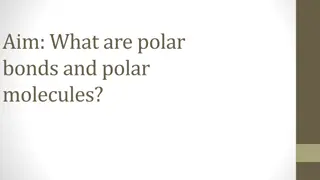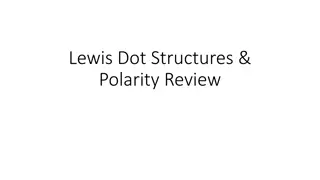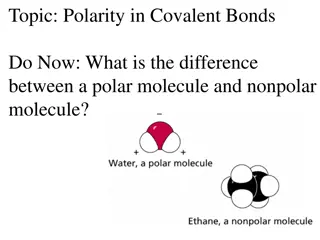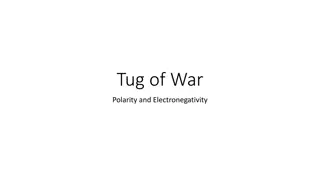Understanding Polarity and Oil Spill Impacts
Explore the concept of polarity in molecules and its impact on interactions, learn about the environmental effects of oil spills, and understand methods used for oil spill cleanup. Discover how polar and nonpolar molecules behave differently and the challenges posed by oil spills on wildlife and eco
2 views • 13 slides
Understanding the Structure and Role of Amino Acids in Proteins
Amino acids are building blocks of proteins, with distinct structures and properties. There are 20 common amino acids found in mammalian proteins, each with a carboxyl group, an amino group, and a unique side chain. The side chains determine the role of an amino acid in a protein, classified as nonp
8 views • 11 slides
Understanding Polar Bonds and Molecules in Chemistry
Learn about polar and nonpolar covalent bonds, the classification of bonds based on electronegativity differences, and how to identify polar molecules through unequal sharing of electrons. Practice determining bond types and grasp the concept of partial charges in polar bonds.
0 views • 18 slides
Lewis Dot Structures and Polarity Review
Learn about Lewis dot structures, how to draw them, determine polarity, and practice drawing various compounds. Understand the concepts of valence electrons, central atoms, bonding, and lone pairs in molecules. Discover the distinction between polar and nonpolar structures based on symmetry.
0 views • 10 slides
Understanding Polarity in Covalent Bonds
The difference between a polar molecule and a nonpolar molecule lies in the distribution of electrons. A polar molecule has an asymmetric electron distribution due to a significant difference in electronegativity, while a nonpolar molecule has a symmetric electron distribution. You can predict polar
0 views • 15 slides
Understanding Solubility, Polarity, and Cleaning in Chemistry
Explore the concepts of solubility in different solvents, the role of polarity in dissolving compounds, and how cleaning agents work based on their polar or nonpolar nature. Discover how soap molecules form micelles to remove stains effectively, and learn about emulsions like mayonnaise where oil an
0 views • 18 slides
Understanding Polarity, Electronegativity, and Chemical Bonds
Delve into the concepts of polarity, electronegativity, and different types of chemical bonds by exploring the tug-of-war analogy and examples of polar, nonpolar, ionic, and covalent bonds. Learn how electronegativity values determine the nature of bonds and the sharing of electrons in molecules.
0 views • 17 slides
Understanding Intermolecular Forces and Dispersion Forces in Molecules
Particle diagrams of liquids, solids, and gases reflect distinct arrangements due to intermolecular forces. The existence of substances as gases, liquids, or solids at room temperature is attributed to the forces between molecules known as intermolecular forces (IMF), with dispersion forces being th
0 views • 30 slides







